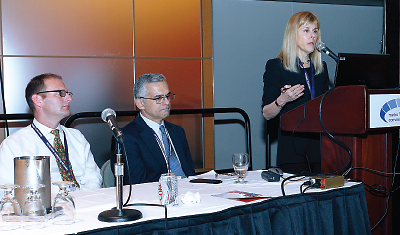Troops Face Complex, but Not Inevitable, Mental Health Issues
Abstract
An individualized approach to the mental health needs of troops and their families can help them adjust to the short- and long-term consequences of wartime deployment.
The 13-plus years that the United States has spent engaged in war has brought the psychological effects of military deployment and combat to the forefront of the nation’s attention.

The presence of PTSD erodes the “healthy soldier effect” and can lead to any of several chronic general medical conditions, says Paula Schnurr, Ph.D., of the Department of Veterans Affairs’ National Center for PTSD. At left are Col. David Benedek and Stephen Cozza, M.D.
Yet those effects are more complex than a quick glance at popular media might suggest, said several speakers at a session on military mental health at APA’s annual meeting in Toronto.
Combat is not the only stressor military service members face in wartime, said U.S. Army Col. David Benedek, a professor and deputy chair of psychiatry at the Uniformed Services University of the Health Sciences. “Troops also face harsh living conditions, bad weather, fear, erratic sleep, worry about families back home, separation from their closest sources of support, and the inevitable physical demands of their jobs.”
Those factors can produce a range of responses among troops in the field or over time, but there is often a difference between combat-stress reactions and full DSM diagnoses, said Benedek.
Ideally, combat stress should be managed close to the front line with brief interventions, so as to encourage rapid recovery, he said. “Currently, we treat depression, anxiety, PTSD, and substance use disorders in theater, which shows how much can be done in forward operating settings.”
Initial symptoms reported during or just after deployment may reflect physical injury or other exposure, but do not necessarily predict long-term morbidity or an inevitable pathway to psychological distress or dysfunction, said Benedek.
In fact, mental health issues relating to military service may not appear until well after an individual’s military career is over and the individual is under the care of a civilian clinician. The presence of other physical conditions may further complicate the ability to recognize the health needs of a service member.
Soldiers are usually healthier than the general population when they enter the service, yet research has shown that veterans with PTSD are more likely to be diagnosed with circulatory, respiratory, and other physical disorders than the general population, said Paula Schnurr, Ph.D., of the Department of Veterans Affairs National Center for PTSD in White River Junction, Vt., and the Geisel School of Medicine at Dartmouth.
“The pathway from trauma to illness may be direct, as in the case of physical harm from an IED blast,” said Schnurr. “More commonly, the path is indirect, arising from an internal reaction to trauma.”
While psychotherapy is unlikely to cure coronary stenosis, treating veterans with PTSD must start early, as treatment can help decrease risky health behaviors, increase compliance, and improve overall functioning, Schnurr said.
Regardless of specialty, clinicians must keep the whole patient in mind, she said. “Mental health providers need to pay attention to physical health, and physical health providers may need to attend to PTSD.”
Because military culture promotes self-reliance and toughness, a high proportion of the psychiatric needs of military personnel and veterans go unmet, said former U.S. Army psychiatrist Charles Engel, M.D., M.P.H., a senior health scientist at the RAND Corporation in Arlington, Va.
“Both cultural [factors] and self-stigma may inhibit treatment seeking, engagement, and adherence,” said Engel. “Underreporting and resistance to proven intervention strategies is a problem at both the health-system and service-member levels.”
Another factor influencing the health of American military service members is the health of their families. Those families today include two million children whose lives can be profoundly affected before, during, and after a parent is deployed to a combat zone, said Stephen Cozza, M.D., a child and adolescent psychiatrist at the Uniformed Services University of the Health Sciences and the Center for the Study of Traumatic Stress.
Many protective factors—such as jobs and incomes, housing, medical care, social support, and a sense of purpose and duty—undergird military families, said Cozza. However, these families also face major stressors as well, not the least of which is the deployment of the military spouse.
“Deployment is not just a matter of separation and return, but also the possibility of the parent returning with illness or injury,” said Cozza. “The distress in children is related to the distress of the nondeployed spouse, who becomes a single parent and can become stretched too thin to provide sufficient care.”
Children may also find it hard to understand or cope with the behavioral changes in a parent who experienced a traumatic brain injury or developed PTSD.
“Most military families get through those experiences with some adjustments, but some need supportive mental health interventions to help manage the stresses they encounter,” said Cozza. “What is needed is not a VA solution and not a DoD solution, but a way of moving those systems to work collaboratively with community partners to better address these problems.” ■
A video interview with Cozza can be viewed here.



